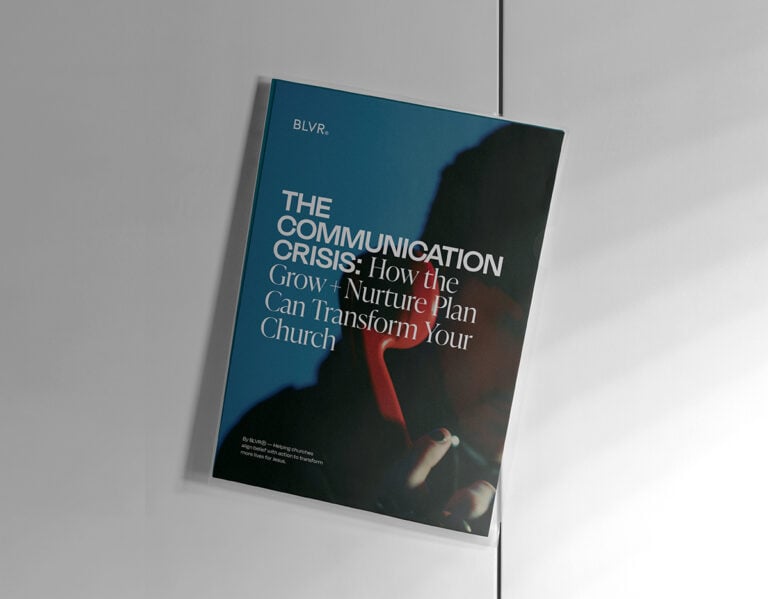
Church Branding / BY Adam Mcwethy
3 Steps to Build an Audience Focused Communications Plan for Your Church
Published On 02.17.2025
Does Your Messaging Resonate with Your Community?
In a world overwhelmed with information, it’s easy for well-intentioned efforts to get lost in the noise. A communication strategy rooted in your belief—a strategy that’s intentional, audience-focused, and actionable—is critical for reaching your lost and nurturing your found. Without it, opportunities to guide people toward transformation are often missed.
This is where the Grow + Nurture Plan comes in. Designed to align your church’s communication with its belief, this framework provides a roadmap for sustainable, impactful messaging that grows your audience and deepens relationships.
Let’s explore three actionable steps to build a belief-driven audience-focused communications plan for your church.
Step 1: Understand Your Audience
Before crafting any message, you need to know who you’re speaking to so that what you’re going to say will land well.
Your community is made up of lots of distinct groups. There are those who are lost, and those who are found. There are people within your church congregation, and there are people who have no connection to your church. There are married couples, and those who are single, divorced and widowed. And there are a whole lot of other ways to categorize your community into audience groups. But these are each sub-categories that should fit within a top-level audience group category based on gender, ages and stages of life.
So, we recommend that your church start by segmenting its audience into categories such as:
- Men and Women
- Kids and Youth
- Young Adults
- Seniors
Step 2: Grow Your Addressable Audience
Once you know who your audience is, the next step is to convert the people in your community from Unaddressable People to Addressable Contacts. When someone is unaddressable, you aren’t able to communicate with them via email, phone, or by mail – because you don’t have their contact information. But when you get a person’s contact information, you are able to communicate with them – and thus they become addressable.
Your contact list is one of the most valuable assets your church has, however far too often churches overlook and underutilize their contact lists. Here are a few things you church should emphasize:
- Segment Your Contact List into Audience Groups: Most church contact lists group everyone into one big bucket. The much better approach is to set up groups, such as Men, Women, Young Adults, and Youth.
- Start With What You Have: Go through your current contact list to clean it up, organize it, fill in any missing information, and place people into the proper audience group(s).
- Add New Contacts Into Your Audience Group Lists: There are a number of different ways to get new people into your audience group lists. Techniques range from visitor information cards, to digital advertising, to buying contact lists of people in your local community.
- Set List Growth Goals: Setting goals is important for keeping people accountable. So look at the size of each audience group contact list today, and then add a growth goal of 10% for a monthly goal or up to 25% for a quarterly goal. Then get to work hitting these goals.
Step 3: Nurture Your Audience
After you understand who your audience is, and after your contact list is set-up around those audience groups – it’s time to begin nurturing them with relevant information on a consistent basis.
In the business world, the goal is to nurture someone through a funnel that goes like this: Awareness > Consideration > Purchase > Retention > Support > Advocacy. Churches have a comparable funnel, that is structured as follows: Hopeless > Find Hope > Get Help > Give Hope + Help. To get people into and walking through this funnel required consistent nurturing.
Following are some things that churches like yours are doing to successfully nurture their community audience:
- Digital and Offline Nurturing: Digital nurturing happens through things like emails, text messages and social posts. Offline nurturing is done through things like handwritten notes, in-person meetings, and physical mailers. A mixture of both digital and offline nurturing should be part of how every church nurtures its people through the funnel.
- Put an Emphasis on Email: Email continues to be the most cost-effective way to communicate with people that also yields great results. Creating an audience group email schedule, and then sticking to it, can be one of the best things your church can do to increase engagement.
- Transitional Moments: A transitional moment is when someone goes from one stage in the funnel to next stage. Through strategic communications, the church has an opportunity to encourage people to take these next steps. Events, one-on-one meetings, and invitations are transitional moments examples.
Conclusion
The Grow + Nurture Plan is more than a strategy—it’s a ministry approach rooted in your church’s belief and calling. By understanding your audience, growing your addressable audience, and then nurturing your audience, your church can:
- Build trust with members and new visitors alike.
- Foster deeper relationships that lead to long-term engagement.
- Expand your church’s impact by meeting people where they are and guiding them toward transformation.
YOUR NEW COMMS PLAN
Learn how your church can apply an approach that businesses have used to successfully acquire new customers and retain existing customers. Use the power of audience segmentation to deliver personalized messages that are relevant to each person within you external and internal church community.

About the Author

Adam Mcwethy
Partner / COO
With almost 25 years of agency experience, Adam has worked with close to 500 brands, including Globe, World Vision, Marcus & Millichap, Creative Planning, and Liberty Station to name a few. Today Adam is focused on helping churches make a larger impact by attracting new guests and fostering deeper engagement from existing members. He is able to do this by bringing the insights he’s learned over the last two-decades of working with businesses to grow and retain their customers.




